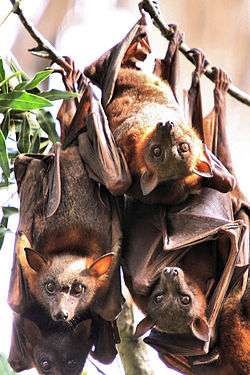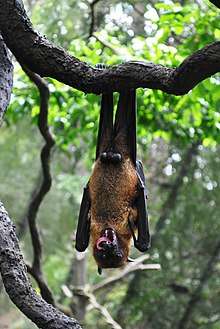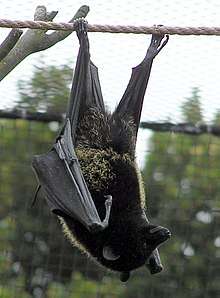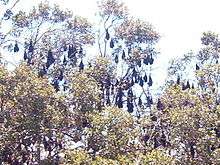Megabat
| Megabats (fruit bats) | |
|---|---|
 | |
| Little red flying foxes, Pteropus scapulatus | |
| Scientific classification | |
| Kingdom: | Animalia |
| Phylum: | Chordata |
| Class: | Mammalia |
| Order: | Chiroptera |
| Suborder: | Megachiroptera or Yinpterochiroptera Dobson, 1875 |
| Family: | Pteropodidae Gray, 1821 |
| Subfamilies | |
| |
Megabats constitute the suborder Megachiroptera, and its only family Pteropodidae of the order Chiroptera (bats). They are also called fruit bats, Old World fruit bats,[1] or, especially the genera Acerodon and Pteropus, flying foxes. Megabats are found in tropical and subtropical areas of Eurasia, Africa, and Oceania.[2][3][4] Compared to insectivorous bats, fruit bats are relatively large, and with some exceptions, do not navigate by echolocation. They are herbivores and rely on their keen senses of sight and smell to locate food.[5]
Description

Most fruit bats are larger than insectivorous bats or Microchiroptera, but a number of small fruit bats exist, also. The smallest species is 6 cm (2.4 in) long, thus smaller than some microbats, for example, the Mauritian tomb bat.[6] The largest attain a wingspan of 1.7 m (5.6 ft), and weigh as much as 1.6 kg (3.5 lb).[7] Most fruit bats have large eyes, allowing them to orient themselves visually in twilight and inside caves and forests.
Their sense of smell is excellent. In contrast to the microbats, the fruit bats do not use echolocation (with one exception, the Egyptian fruit bat Rousettus egyptiacus, which uses high-pitched tongue clicks to navigate in caves).[8]
Loss of echolocation
Megabats make up the only family (Pteropodidae) in order Chiroptera that is not capable of laryngeal echolocation. Echolocation and flight evolved early in the lineage of chiropterans. Although echolocation was later lost in family Pteropodidae,[9] bats in the genus Rousettus are capable of primitive echolocation through clicking their tongues,[10] and some species have been shown to create clicks similar to those of echolocating bats using their wings.[11][12]
Both echolocation and flight are energetically expensive processes.[13] The nature of the flight and echolocation mechanism of bats allows for creation of echolocation pulses with minimal energy use.[14] Energetic coupling of these two processes is thought to have allowed for both energetically expensive processes to evolve in bats. The loss of echolocation may be due to the uncoupling of flight and echolocation in megabats.[15] The larger average body size of megabats compared to echolocating bats[16] suggests that a larger body size disrupts the flight-echolocation coupling and made echolocation too energetically expensive to be conserved in megabats.[15]
Behavior and ecology
Megabats mostly roost in trees and shrubs. Only those that possess echolocation venture into the dark recesses of caves. Because they eat fruit, some megabat species are unpopular with orchard owners. They are frugivorous or nectarivorous, i.e., they eat fruits or lick nectar from flowers. Often, the fruits are crushed and only their juice is consumed, while the remaining fibrous matter is discarded. The teeth are adapted to bite through hard fruit rinds, and ridges on the soft palate help to squeeze out the juices within.
Frugivorous bats aid the distribution of plants (and therefore forests) by carrying the fruits with them and spitting the seeds or eliminating them elsewhere. Nectarivores actually pollinate visited plants. They bear long tongues that are inserted deep into the flower; pollen passed to the bat is then transported to the next blossom visited, thereby pollinating it. This relationship between plants and bats is a form of mutualism known as "chiropterophily". Examples of plants that benefit from this arrangement include the baobabs of the genus Adansonia and the sausage tree (Kigelia).
As disease reservoirs

Fruit bats have been found to act as reservoirs for Ebola virus,[17] though the bats themselves sometimes have no signs of infection. Three species of bats have tested positive for Ebola, but had no symptoms of the virus.[17] This indicates that the bats may be acting as a reservoir for the virus. Of the infected animals identified during these field collections, immunoglobulin G (IgG) specific for ebola virus was detected in hammer-headed bats, Franquet's epauletted fruit bats, and little collared fruit bats.
The epidemical Marburg virus was found in 2007 in specimens of the Egyptian fruit bat, confirming the suspicion that this species may be a reservoir for this virus.[18]
Other viral diseases which can be carried by fruit bats include Australian bat lyssavirus and henipavirus (notably Hendra virus and Nipah virus), both of which can prove fatal to humans. These bats have been shown to infect other species (specifically horses) with Hendra virus in Australian regions. Later, humans became infected with Hendra virus after being exposed to horse bodily fluids and excretions.[19] The discovery of this Australian bat lyssavirus was in 1996, before this all bats on all continents, except Australia, had been recorded to carry this rabies-like disease.[20]
Fruit bats are considered a delicacy by South Pacific Islanders, as well as in Micronesia. Consumption has been suggested as a cause of Lytico-Bodig disease on the Micronesian island of Guam, through bioaccumulation of a plant toxin to which the bats are immune.[21] The transmission of Nipah virus from flying foxes to pigs is thought to be due to an increasing overlap between bat habitats and piggeries in peninsular Malaysia. At the index farm, fruit orchards were in close proximity to the piggery, allowing the spillage of urine, faeces, and partially eaten fruit onto the pigs. Retrospective studies demonstrate that viral spillover into pigs may have been occurring in Malaysia since 1996 without detection. During 1998, viral spread was aided by the transfer of infected pigs to other farms, where new outbreaks occurred.
Classification
.jpg)


Bats have been traditionally thought to belong to one of two monophyletic groups, a view that is reflected in their classification into two suborders (Megachiroptera and Microchiroptera). According to this hypothesis, all living megabats and microbats are descendants of a common ancestor species that was already capable of flight.
However, other views have been shared, and a vigorous debate persists to this date. For example, in the 1980s and 1990s, some researchers proposed (based primarily on the similarity of the visual pathways) that the Megachiroptera were in fact more closely affiliated with the primates than the Microchiroptera, with the two groups of bats having therefore evolved flight via convergence (see Flying primates theory).[22] However, a recent flurry of genetic studies confirms the more longstanding notion that all bats are indeed members of the same clade, the Chiroptera.[23][24] Other studies have recently suggested that certain families of microbats (possibly the horseshoe bats, mouse-tailed bats, and the false vampires) are evolutionarily closer to the fruit bats than to other microbats.[23][25]
List of species
The family Pteropodidae is divided into seven subfamilies with 186 total extant species, represented by 44–46 genera:
Family Pteropodidae
- Subfamily Nyctimeninae
- Genus Nyctimene – tube-nosed fruit bats
- Broad-striped tube-nosed fruit bat, N. aello
- Common tube-nosed fruit bat, N. albiventer
- Pallas's tube-nosed bat, N. cephalotes
- Dark tube-nosed fruit bat, N. celaeno
- Mountain tube-nosed fruit bat, N. certans
- Round-eared tube-nosed fruit bat, N. cyclotis
- Dragon tube-nosed fruit bat, N. draconilla
- Keast's tube-nosed fruit bat, N. keasti
- Island tube-nosed fruit bat, N. major
- Malaita tube-nosed fruit bat, N. malaitensis
- Demonic tube-nosed fruit bat, N. masalai
- Lesser tube-nosed bat, N. minutus
- Philippine tube-nosed fruit bat, N. rabori
- Eastern tube-nosed bat, N. robinsoni
- Nendo tube-nosed fruit bat, N. sanctacrucis (early 20th century †)
- Umboi tube-nosed fruit bat, N. vizcaccia
- Genus Paranyctimene
- Lesser tube-nosed fruit bat, Paranyctimene raptor
- Steadfast tube-nosed fruit bat, Paranyctimene tenax
- Genus Nyctimene – tube-nosed fruit bats
- Subfamily Cynopterinae
- Genus Aethalops – pygmy fruit bats
- Borneo fruit bat, A. aequalis
- Pygmy fruit bat, A. alecto
- Genus Alionycteris
- Mindanao pygmy fruit bat, A. paucidentata
- Genus Balionycteris
- Spotted-winged fruit bat, B. maculata
- Genus Chironax
- Black-capped fruit bat, C. melanocephalus
- Genus Cynopterus – dog-faced fruit bats or short-nosed fruit bats
- Lesser short-nosed fruit bat, C. brachyotis
- Horsfield's fruit bat, C. horsfieldii
- Peters's fruit bat, C. luzoniensis
- Minute fruit bat, C. minutus
- Nusatenggara short-nosed fruit bat, Cynopterus nusatenggara
- Greater short-nosed fruit bat, C. sphinx
- Indonesian short-nosed fruit bat, C. titthaecheilus
- Genus Dyacopterus – Dayak fruit bats
- Brooks's dyak fruit bat, D. brooksi
- Rickart's dyak fruit bat, D. rickarti
- Dayak fruit bat, D. spadiceus
- Genus Haplonycteris
- Fischer's pygmy fruit bat, H. fischeri
- Genus Latidens
- Salim Ali's fruit bat, L. salimalii
- Genus Megaerops
- Tailless fruit bat, M. ecaudatus
- Javan tailless fruit bat, M. kusnotoi
- Ratanaworabhan's fruit bat, M. niphanae
- White-collared fruit bat, M. wetmorei
- Genus Otopteropus
- Luzon fruit bat, O. cartilagonodus
- Genus Penthetor
- Dusky fruit bat, P. lucasi
- Genus Ptenochirus – musky fruit bats
- Greater musky fruit bat, P. jagori
- Lesser musky fruit bat, P. minor
- Genus Sphaerias
- Blanford's fruit bat, S. blanfordi
- Genus Thoopterus
- Swift fruit bat, T. nigrescens
- Genus Aethalops – pygmy fruit bats
- Subfamily Harpiyonycterinae
- Genus Aproteles
- Bulmer's fruit bat, A. bulmerae
- Genus Dobsonia – naked-backed fruit bats
- Andersen's naked-backed fruit bat, D. anderseni
- Beaufort's naked-backed fruit bat, D. beauforti
- Philippine bare-backed fruit bat, D. chapmani
- Halmahera naked-backed fruit bat, D. crenulata
- Biak naked-backed fruit bat, D. emersa
- Sulawesi naked-backed fruit bat, D. exoleta
- Solomon's naked-backed fruit bat, D. inermis
- Lesser naked-backed fruit bat, D. minor
- Moluccan naked-backed fruit bat, D. moluccensis
- Panniet naked-backed fruit bat, D. pannietensis
- Western naked-backed fruit bat, D. peroni
- New Britain naked-backed fruit bat, D. praedatrix
- Greenish naked-backed fruit bat, D. viridis
- Genus Harpyionycteris
- Sulawesi harpy fruit bat, H. celebensis
- Harpy fruit bat, H. whiteheadi
- Genus Aproteles
- Subfamily Macroglossinae
- Genus Macroglossus – long-tongued fruit bats
- Long-tongued nectar bat, M. minimus
- Long-tongued fruit bat, M. sobrinus
- Genus Melonycteris
- Fardoulis' blossom bat, M. fardoulisi
- Black-bellied fruit bat, M. melanops
- Woodford's fruit bat, M. woodfordi
- Genus Notopteris – long-tailed fruit bats
- Long-tailed fruit bat, N. macdonaldi (Fiji and Vanuatu)
- New Caledonia blossom bat, N. neocaledonica (New Caledonia)
- Genus Syconycteris – blossom bats
- Common blossom bat, S. australis
- Halmahera blossom bat, S. carolinae
- Moss-forest blossom bat, S. hobbit
- Genus Macroglossus – long-tongued fruit bats
- Subfamily Pteropodinae
- Genus Acerodon
- Sulawesi flying fox, A. celebensis
- Talaud flying fox, A. humilis
- Giant golden-crowned flying fox, A. jubatus
- Palawan fruit bat, A. leucotis
- Sunda flying fox, A. mackloti
- Genus Desmalopex
- White-winged flying fox, Desmalopex leucopterus
- Small white-winged flying fox, Desmalopex microleucopterus
- Genus Eidolon – straw-coloured fruit bats
- Madagascan fruit bat, E. dupreanum
- Straw-coloured fruit bat, E. helvum
- Genus Mirimiri
- Fijian monkey-faced bat, M. acrodonta
- Genus Neopteryx
- Small-toothed fruit bat, N. frosti
- Genus Pteralopex
- Bougainville monkey-faced bat, P. anceps
- Guadalcanal monkey-faced bat, P. atrata
- Greater monkey-faced bat, P. flanneryi
- Montane monkey-faced bat, P. pulchra
- New Georgian monkey-faced bat, P. taki
- Genus Pteropus – flying foxes
- P. alecto species group
- Black flying fox, P. alecto
- P. caniceps species group
- Ashy-headed flying fox, P. caniceps
- P. chrysoproctus species group
- Silvery flying fox, P. argentatus
- Moluccan flying fox, P. chrysoproctus
- Makira flying fox, P. cognatus
- Banks flying fox, P. fundatus
- Solomons flying fox, P. rayneri
- Rennell flying fox, P. rennelli
- P. conspicillatus species group
- Spectacled flying fox, P. conspicillatus
- Ceram fruit bat, P. ocularis
- P. livingstonii species group
- Aru flying fox, P. aruensis
- Kei flying fox, P. keyensis
- Livingstone's fruit bat, P. livingstonii
- Black-bearded flying fox, P. melanopogon
- P. mariannus species group
- Okinawa flying fox, P. loochoensis
- Mariana fruit bat, P. mariannus
- Pelew flying fox, P. pelewensis
- Kosrae flying fox, P. ualanus
- Yap flying fox, P. yapensis
- P. melanotus species group
- Black-eared flying fox, P. melanotus
- P. molossinus species group
- Lombok flying fox, P. lombocensis
- Caroline flying fox, P. molossinus
- Rodrigues flying fox, P. rodricensis
- P. neohibernicus species group
- Great flying fox, P. neohibernicus
- P. niger species group
- Aldabra flying fox, P. aldabrensis
- Mauritian flying fox, P. niger
- Madagascan flying fox, P. rufus
- Seychelles fruit bat, P. seychellensis
- Pemba flying fox, P. voeltzkowi
- P. personatus species group
- Bismark masked flying fox, P. capistratus
- Masked flying fox, P. personatus
- Temminck's flying fox, P. temminckii
- P. poliocephalus species group
- Big-eared flying fox, P. macrotis
- Geelvink Bay flying fox, P. pohlei
- Grey-headed flying fox, P. poliocephalus
- P. pselaphon species group
- Chuuk flying fox, P. insularis
- Temotu flying fox, P. nitendiensis
- Large Palau flying fox, P. pilosus (19th century †)
- Bonin flying fox, P. pselaphon
- Guam flying fox, P. tokudae (1970s †)
- Insular flying fox, P. tonganus
- Vanikoro flying fox, P. tuberculatus
- New Caledonia flying fox, P. vetulus
- P. samoensis species group
- Vanuatu flying fox, P. anetianus
- Samoa flying fox, P. samoensis
- P. scapulatus species group
- Gilliard's flying fox, P. gilliardorum
- Lesser flying fox, P. mahaganus
- Little red flying fox, P. scapulatus
- Dwarf flying fox, P. woodfordi
- P. subniger species group
- Admiralty flying fox, P. admiralitatum
- Dusky flying fox, P. brunneus (19th century †)
- Ryukyu flying fox, P. dasymallus
- Nicobar flying fox, P. faunulus
- Gray flying fox, P. griseus
- Ontong Java flying fox, P. howensis
- Small flying fox, P. hypomelanus
- Ornate flying fox, P. ornatus
- Little golden-mantled flying fox, P. pumilus
- Philippine gray flying fox, P. speciosus
- Small Mauritian flying fox, P. subniger (19th century †)
- P. vampyrus species group
- Indian flying fox, P. giganteus
- Andersen's flying fox, P. intermedius
- Lyle's flying fox, P. lylei
- Large flying fox, P. vampyrus
- incertae sedis
- Small Samoan flying fox, P. allenorum (19th century †)
- Large Samoan flying fox, P. coxi (19th century †)
- P. alecto species group
- Genus Styloctenium
- Mindoro stripe-faced fruit bat, S. mindorensis
- Sulawesi stripe-faced fruit bat, S. wallacei
- Genus Acerodon
- Subfamily Rousettinae
- Genus Eonycteris – dawn fruit bats
- Greater nectar bat, E. major
- Cave nectar bat, E. spelaea
- Philippine dawn bat, E. robusta
- Genus Rousettus – rousette fruit bats
- Subgenus Boneia
- Manado fruit bat, R. (B.) bidens
- Subgenus Rousettus
- Geoffroy's rousette, R. amplexicaudatus
- Sulawesi rousette, R. celebensis
- Egyptian fruit bat or Egyptian rousette, R. aegyptiacus
- Leschenault's rousette, R. leschenaulti
- Linduan rousette, R. linduensis
- Comoro rousette, R. obliviosus
- Bare-backed rousette, R. spinalatus
- Subgenus Stenonycteris
- Long-haired rousette, R. (S.) lanosus
- Madagascan rousette, R. (S.) madagascariensis
- Subgenus Boneia
- Genus Eonycteris – dawn fruit bats
- Subfamily Epomophorinae
- Tribe Epomophorini
- Genus Epomophorus – epauletted fruit bats
- Angolan epauletted fruit bat, E. angolensis
- Ansell's epauletted fruit bat, E. anselli
- Peters's epauletted fruit bat, E. crypturus
- Gambian epauletted fruit bat, E. gambianus
- Lesser Angolan epauletted fruit bat, E. grandis
- Ethiopian epauletted fruit bat, E. labiatus
- East African epauletted fruit bat, E. minimus
- Minor epauletted fruit bat, E. minor
- Wahlberg's epauletted fruit bat, E. wahlbergi
- Genus Epomops – epauletted bats
- Buettikofer's epauletted fruit bat, E. buettikoferi
- Dobson's fruit bat, E. dobsoni
- Franquet's epauletted fruit bat, E. franqueti
- Genus Hypsignathus
- Hammer-headed bat, H. monstrosus
- Genus Micropteropus – dwarf epauletted bats
- Hayman's dwarf epauletted fruit bat, M. intermedius
- Peters's dwarf epauletted fruit bat, M. pusillus
- Genus Nanonycteris
- Veldkamp's dwarf epauletted fruit bat, N. veldkampii
- Genus Epomophorus – epauletted fruit bats
- Tribe Myonycterini
- Genus Lissonycteris
- Angolan rousette, L. angolensis
- Genus Megaloglossus
- Woermann's bat, M. woermanni
- Genus Myonycteris – little collared fruit bats
- São Tomé collared fruit bat, M. brachycephala
- East African little collared fruit bat, M. relicta
- Little collared fruit bat, M. torquata
- Genus Lissonycteris
- Tribe Plerotini
- Genus Plerotes
- D'Anchieta's fruit bat, P. anchietae
- Genus Plerotes
- Tribe Scotonycterini
- Genus Casinycteris
- Short-palated fruit bat, C. argynnis
- Genus Scotonycteris
- Zenker's fruit bat, S. zenkeri
- Pohle's fruit bat, S. ophiodon
- Genus Casinycteris
- Tribe Epomophorini
References
- ↑ Mickleburgh SP, Hutson AM, Racey PA. "Old World Fruit Bats: Introduction". International Union for Conservation of Nature. Archived from the original on 17 March 2014. Retrieved July 19, 2013.
- ↑ "Our European Bats". BatLife Europe. Retrieved 24 April 2017.
- ↑ Luzynski KC, Sluzas EM, Wallen MM. "Pteropodidae: Old World fruit bats". Animal Diversity Web/University of Michigan.
- ↑ Smith CH. "PTEROPODIDAE (Fruit Bats/Flying Foxes)". MAMMFAUN. Western Kentucky University. (includes range map)
- ↑ Neuweiler G (2000). The Biology of Bats. Oxford University Press. ISBN 978-0-19-509950-8. Retrieved 28 March 2015.
- ↑ Garbutt N (2007). "Mauritian Tomb Bat". Mammals of Madagascar: A Complete Guide. Yale University Press. p. 67. ISBN 978-0-300-12550-4.
- ↑ Nowak R (1999). "Walker's Mammals of the World" (6 ed.). pp. 264–271. ISBN 978-0-8018-5789-8. Missing or empty
|url=(help) - ↑ Airas M. "Echolocation in bats" (PDF). Laboratory of Acoustics and Audio Signal Processing, São Paulo State University. p. 4. Archived from the original (PDF) on April 11, 2015. Retrieved July 19, 2013.
- ↑ Springer MS, Teeling EC, Madsen O, Stanhope MJ, de Jong WW (May 2001). "Integrated fossil and molecular data reconstruct bat echolocation". Proceedings of the National Academy of Sciences of the United States of America. 98 (11): 6241–6. Bibcode:2001PNAS...98.6241S. doi:10.1073/pnas.111551998. PMC 33452. PMID 11353869.
- ↑ Holland RA, Waters DA, Rayner JM (December 2004). "Echolocation signal structure in the Megachiropteran bat Rousettus aegyptiacus Geoffroy 1810". The Journal of Experimental Biology. 207 (Pt 25): 4361–9. doi:10.1242/jeb.01288. PMID 15557022.
- ↑ Boonman A, Bumrungsri S, Yovel Y (December 2014). "Nonecholocating fruit bats produce biosonar clicks with their wings". Current Biology. 24 (24): 2962–7. doi:10.1016/j.cub.2014.10.077. PMID 25484290.
- ↑ Ravindran S (4 December 2014). "When It Comes to Echolocation, Some Bats Just Wing It". National Geographic.
- ↑ Speakman JR, Racey PA (April 1991). "No cost of echolocation for bats in flight". Nature. 350 (6317): 421–3. Bibcode:1991Natur.350..421S. doi:10.1038/350421a0. PMID 2011191.
- ↑ Lancaster WC, Henson OW, Keating AW (January 1995). "Respiratory muscle activity in relation to vocalization in flying bats". The Journal of Experimental Biology. 198 (Pt 1): 175–91. PMID 7891034.
- 1 2 Altringham J (2011). Echolocation and other senses. New York: Oxford University Press.
- ↑ Hutcheon J, Garland T (1995). "Are megabats big?". Journal of Mammalian Evolution. 11 (3/4): 257–277. doi:10.1023/B:JOMM.0000047340.25620.89.
- 1 2 Quammen D (October 2007). "Deadly Contact". National Geographic: 78–105.
- ↑ "Deadly Marburg virus discovered in fruit bats". msnbc. August 21, 2007. Retrieved 2008-03-11.
- ↑ "Hendra Virus Disease & Nipah Virus Encephalitis Fact Sheet" (PDF). CDC. Archived from the original (PDF) on 3 March 2016. Retrieved 20 February 2014.
- ↑ Fraser GC, Hooper PT, Lunt RA, Gould AR, Gleeson LJ, Hyatt AD, Russell GM, Kattenbelt JA (October 1996). "Encephalitis caused by a Lyssavirus in fruit bats in Australia". Emerging Infectious Diseases. 2 (4): 327–31. doi:10.3201/eid0204.960408. PMC 2639915. PMID 8969249.
- ↑ Monson CS, Banack SA, Cox PA (2003). "Conservation implications of Chamorro consumption of flying foxes as a possible cause of amyotrophic lateral sclerosis-parkinsonism dementia complex in Guam". Conservation Biology. 17 (3): 678–686. doi:10.1046/j.1523-1739.2003.02049.x.
- ↑ Pettigrew JD, Jamieson BG, Robson SK, Hall LS, McAnally KI, Cooper HM (1989). "Phylogenetic relations between microbats, megabats and primates (Mammalia: Chiroptera and Primates)". Philosophical Transactions of the Royal Society B. 325 (1229): 489–559. Bibcode:1989RSPTB.325..489P. doi:10.1098/rstb.1989.0102.
- 1 2 Eick GN, Jacobs DS, Matthee CA (September 2005). "A nuclear DNA phylogenetic perspective on the evolution of echolocation and historical biogeography of extant bats (chiroptera)". Molecular Biology and Evolution. 22 (9): 1869–86. doi:10.1093/molbev/msi180. PMID 15930153. Archived from the original (Free full text) on 2009-02-13.
- ↑ Simmons NB, Seymour KL, Habersetzer J, Gunnell GF (February 2008). "Primitive Early Eocene bat from Wyoming and the evolution of flight and echolocation" (PDF). Nature. 451 (7180): 818–21. Bibcode:2008Natur.451..818S. doi:10.1038/nature06549. PMID 18270539.
recent studies unambiguously support bat monophyly
- ↑ Adkins RM, Honeycutt RL (November 1991). "Molecular phylogeny of the superorder Archonta" (PDF). Proceedings of the National Academy of Sciences of the United States of America. 88 (22): 10317–21. Bibcode:1991PNAS...8810317A. doi:10.1073/pnas.88.22.10317. PMC 52919. PMID 1658802.
| Wikimedia Commons has media related to Pteropodidae. |
Further reading
- Myers P (2001). "Pteropodidae (On-line)". Animal Diversity Web. Retrieved 26 December 2006.
- Teeling EC, Springer MS, Madsen O, Bates P, O'brien SJ, Murphy WJ (January 2005). "A molecular phylogeny for bats illuminates biogeography and the fossil record". Science. 307 (5709): 580–4. Bibcode:2005Sci...307..580T. doi:10.1126/science.1105113. PMID 15681385.
- Leroy EM, Kumulungui B, Pourrut X, Rouquet P, Hassanin A, Yaba P, Délicat A, Paweska JT, Gonzalez JP, Swanepoel R (December 2005). "Fruit bats as reservoirs of Ebola virus". Nature. 438 (7068): 575–6. Bibcode:2005Natur.438..575L. doi:10.1038/438575a. PMID 16319873.
External links
- Bat World Sanctuary
- Rodrigues Fruit Bats
- Bat Conservation International
- Criticism of the molecular evidence for bat monophyly
- Brief history of Megachiroptera / Megabats
- Bat World Sanctuary
- Bat Conservation International
- Brief history of Megachiroptera / Megabats
- View the pteVam1 genome assembly in the UCSC Genome Browser.